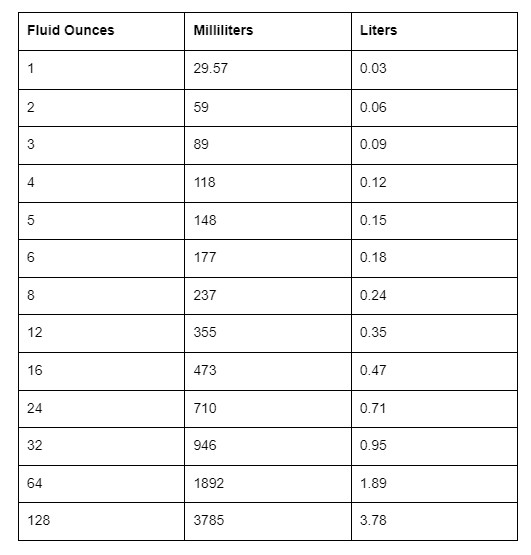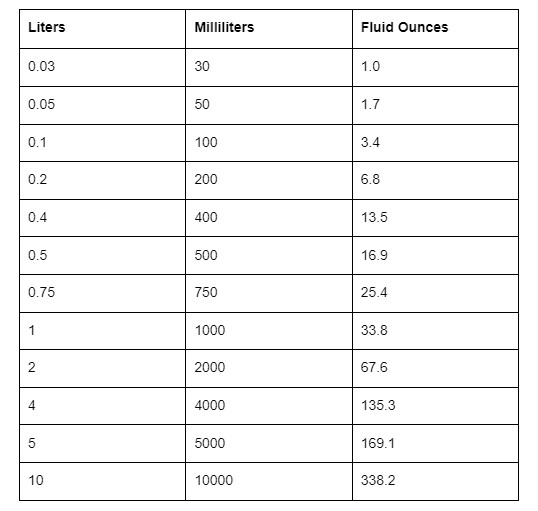Are you ever in the middle of a recipe and stumble upon measurements that just don’t make sense? Especially when it comes to fluid ounces and milliliters, confusion can quickly set in. Don’t let measurement conversions derail your cooking or baking adventures! This comprehensive guide will clearly explain the relationship between fluid ounces (oz) and milliliters (ml), providing you with the knowledge and tools to convert between these units effortlessly. Mastering this simple conversion will ensure accuracy in all your recipes and culinary creations.
Understanding Fluid Ounces and Milliliters: A Quick Overview
Before diving into the conversion, let’s clarify what fluid ounces and milliliters are and why understanding their difference is important, especially in cooking and baking.
Fluid Ounces (fl oz): A fluid ounce is a unit of volume commonly used in the United States and other imperial systems. It’s specifically used to measure liquids. You’ll often see fluid ounces in recipes, beverage containers, and measuring cups designed for liquids.
Milliliters (ml): A milliliter is a metric unit of volume, equal to one thousandth of a liter. It’s widely used around the world for measuring liquids and is a standard unit in science, medicine, and everyday measurements. The metric system, including milliliters, is favored for its simplicity and consistency.
Knowing how to convert between these two units is crucial for anyone who cooks, bakes, or needs to work with recipes from different countries or sources that use varying measurement systems. Accuracy in measurements, particularly in baking, can significantly impact the outcome of your dishes.
The Key Conversion Factor: How Many Milliliters in an Ounce?
The essential conversion factor you need to remember is:
1 fluid ounce (fl oz) is approximately equal to 29.5735 milliliters (ml)
For practical purposes in cooking and baking, you can often round this to 29.6 ml or even 30 ml for estimations, though using the more precise figure ensures greater accuracy, especially when dealing with larger quantities or recipes requiring precise ingredient ratios.
Step-by-Step Guide: Converting Fluid Ounces to Milliliters (fl oz to ml)
To convert fluid ounces to milliliters, simply multiply the number of fluid ounces by 29.5735.
Formula: Milliliters (ml) = Fluid Ounces (fl oz) x 29.5735
Example: Let’s say you have a recipe calling for 5 fluid ounces of milk and you need to know the measurement in milliliters.
Milliliters (ml) = 5 fl oz x 29.5735
Milliliters (ml) ≈ 147.87 ml
Therefore, 5 fluid ounces is approximately equal to 147.87 milliliters.
Step-by-Step Guide: Converting Milliliters to Fluid Ounces (ml to fl oz)
To convert milliliters to fluid ounces, you divide the number of milliliters by 29.5735.
Formula: Fluid Ounces (fl oz) = Milliliters (ml) / 29.5735
Example: Imagine you need to convert 200 milliliters of water to fluid ounces for a recipe that uses imperial measurements.
Fluid Ounces (fl oz) = 200 ml / 29.5735
Fluid Ounces (fl oz) ≈ 6.76 fl oz
So, 200 milliliters is approximately equal to 6.76 fluid ounces.
Practical Applications and Why Accurate Conversions Matter
Understanding this conversion is incredibly useful in various scenarios:
- Cooking and Baking: Recipes from different regions may use different measurement systems. Converting between fluid ounces and milliliters allows you to accurately follow recipes regardless of their origin. Especially in baking, precise measurements are crucial for achieving the desired texture and outcome.
- Following International Recipes: Many international recipes, particularly those from countries using the metric system, will list liquid ingredients in milliliters. Converting to fluid ounces helps if your measuring tools are in imperial units.
- Adjusting Recipe Quantities: If you need to scale a recipe up or down, understanding the ml to oz conversion ensures you maintain the correct proportions of liquid ingredients.
- Nutrition and Dieting: Nutritional information on food packaging often lists serving sizes in milliliters or fluid ounces. Being able to convert between them helps in accurately tracking your intake.
Quick Conversion Chart: Fluid Ounces to Milliliters
For quick reference, here’s a handy conversion chart for common fluid ounce measurements:
| Fluid Ounces (fl oz) | Milliliters (ml) (Approximate) |
|---|---|
| 1 fl oz | 29.57 ml |
| 2 fl oz | 59.15 ml |
| 3 fl oz | 88.72 ml |
| 4 fl oz | 118.29 ml |
| 5 fl oz | 147.87 ml |
| 6 fl oz | 177.44 ml |
| 8 fl oz (1 cup) | 236.59 ml |
| 10 fl oz | 295.74 ml |
| 16 fl oz (1 pint) | 473.18 ml |
| 32 fl oz (1 quart) | 946.35 ml |



Please note: These are approximate values rounded to two decimal places for convenience.
Common Questions About Fluid Ounces and Milliliters
Is 1 oz the same as 30 ml?
While 30 ml is very close to 1 fluid ounce (which is approximately 29.5735 ml), they are not exactly the same. For most everyday cooking purposes, using 30 ml as an approximation for 1 fluid ounce is acceptable. However, for precise measurements, especially in scientific or baking contexts, using the accurate conversion factor is recommended.
How many ml in 2 fl oz?
Using our conversion factor, 2 fluid ounces is approximately 59.147 milliliters (2 fl oz x 29.5735 ml/fl oz ≈ 59.147 ml). As seen in our chart, this is roughly 59.15 ml.
Why are fluid ounces and dry ounces different?
It’s important to distinguish between fluid ounces and dry ounces. Fluid ounces measure volume (specifically of liquids), while dry ounces measure weight or mass. One fluid ounce of water will not weigh one dry ounce. Dry ounces are typically used for ingredients like flour, sugar, and solids, while fluid ounces are for liquids like water, milk, and juice. This guide focuses specifically on fluid ounces and their conversion to milliliters.
In Conclusion: Mastering the ml to oz Conversion for Culinary Success
Understanding the relationship between milliliters and fluid ounces is a fundamental skill for anyone who spends time in the kitchen. Knowing that approximately 29.57 milliliters are in 1 fluid ounce empowers you to confidently navigate recipes from various sources, adjust measurements as needed, and ensure accuracy in your culinary endeavors. With this knowledge and the simple conversion techniques provided, you can say goodbye to measurement confusion and hello to consistent, delicious results every time you cook or bake!